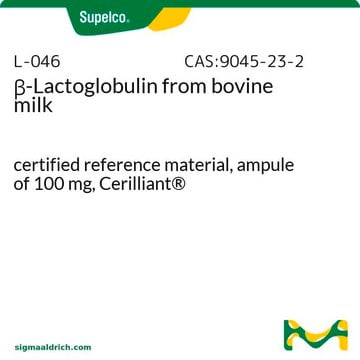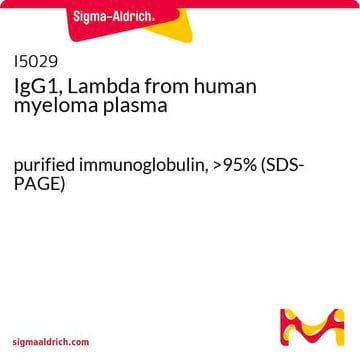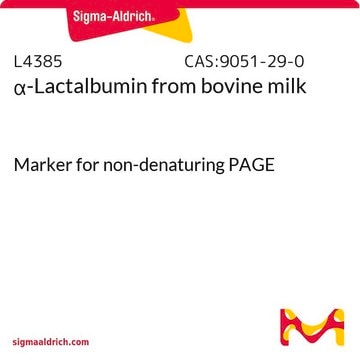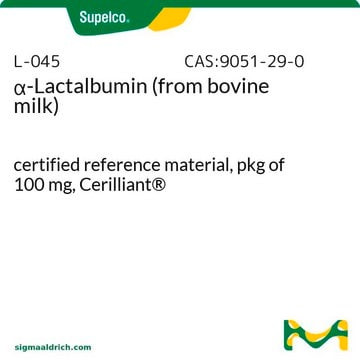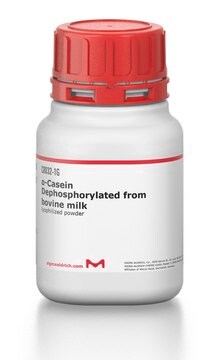L0130
β-Lactoglobulin from bovine milk
≥90% (PAGE), lyophilized powder
Synonym(s):
β-LG, Bos d 5, beta-LG
Sign Into View Organizational & Contract Pricing
All Photos(2)
About This Item
Recommended Products
biological source
bovine milk
Assay
≥90% (PAGE)
form
lyophilized powder
UniProt accession no.
storage temp.
2-8°C
Gene Information
bovine ... LGB(280838)
Looking for similar products? Visit Product Comparison Guide
General description
A member of the lipocalin family, β-Lactoglobulin (βLg) is a small protein of 162 amino acids with a molecular mass of ∼18,400 Da. It features an eight-stranded β-barrel (strands A-H) succeeded by a three-turn a-helix and a final β-strand (strand I) that forms part of the dimerization interface.
Milk from dairy cows contains the protein β-lactoglobulin (BLG). It naturally occurs in a number of genetic variants, and the most prevalent bovine variants are BLG A and BLG B.
Application
β-Lactoglobulin from bovine milk was used to test the allergen-responsive CD4+ CD25+ regulatory T cells in children who have outgrown cow′s milk allergy. It is also used to test the competitive displacement of β-lactoglobulin by Tween 20 from oil-water and air-water interfaces.
Other Notes
Contains β-lactoglobulins A and B which can be isolated chromatographically.
Quality
May not contain folate binding protein; not recommended for folate analysis.
Preparation Note
Crystallized
Storage Class Code
11 - Combustible Solids
WGK
WGK 3
Flash Point(F)
Not applicable
Flash Point(C)
Not applicable
Personal Protective Equipment
dust mask type N95 (US), Eyeshields, Gloves
Choose from one of the most recent versions:
Certificates of Analysis (COA)
Lot/Batch Number
Don't see the Right Version?
If you require a particular version, you can look up a specific certificate by the Lot or Batch number.
Already Own This Product?
Find documentation for the products that you have recently purchased in the Document Library.
Customers Also Viewed
A Heinzmann et al.
International archives of allergy and immunology, 120(4), 280-286 (2000-01-21)
beta-Lactoglobulin (BLG) represents one of the major allergens causing cow's milk allergy (CMA) - a disease with a wide spectrum of clinical symptoms. The aim of this study was to evaluate sequential B cell epitopes of BLG by the Pin-ELISA
Nicholas A Smith et al.
Brain, behavior, and immunity, 95, 122-141 (2021-03-12)
A number of studies have reported comorbidity of food allergies with various neuropsychiatric disorders, such as anxiety, depression, attention-deficit hyperactivity disorder, and autism. However, inconsistent results across clinical studies have left the association between food allergy and behavioral disorders inconclusive.
Isabella Pali-Schöll et al.
Clinical and translational allergy, 12(2), e12125-e12125 (2022-02-17)
Growing up on a cattle farm and consuming raw cow's milk protects against asthma and allergies. We expect a cattle-specific protein as active component in this farm effect. Dust was collected from cattle and poultry stables and from mattresses of
Tristan Bourdeau et al.
Nutrients, 13(9) (2021-09-29)
Human clinical trials have shown that a specific partially hydrolyzed 100% whey-based infant formula (pHF-W) reduces AD risk in the first yeast of life. Meta-analyses with a specific pHF-W (pHF-W1) confirm a protective effect while other meta-analyses pooling different pHF-W
André C Dumetz et al.
Biophysical journal, 94(2), 570-583 (2007-12-28)
The aggregates and gels commonly observed during protein crystallization have generally been considered disordered phases without further characterization. Here their physical nature is addressed by investigating protein salting-out in ammonium sulfate and sodium chloride for six proteins (ovalbumin, ribonuclease A
Our team of scientists has experience in all areas of research including Life Science, Material Science, Chemical Synthesis, Chromatography, Analytical and many others.
Contact Technical Service





